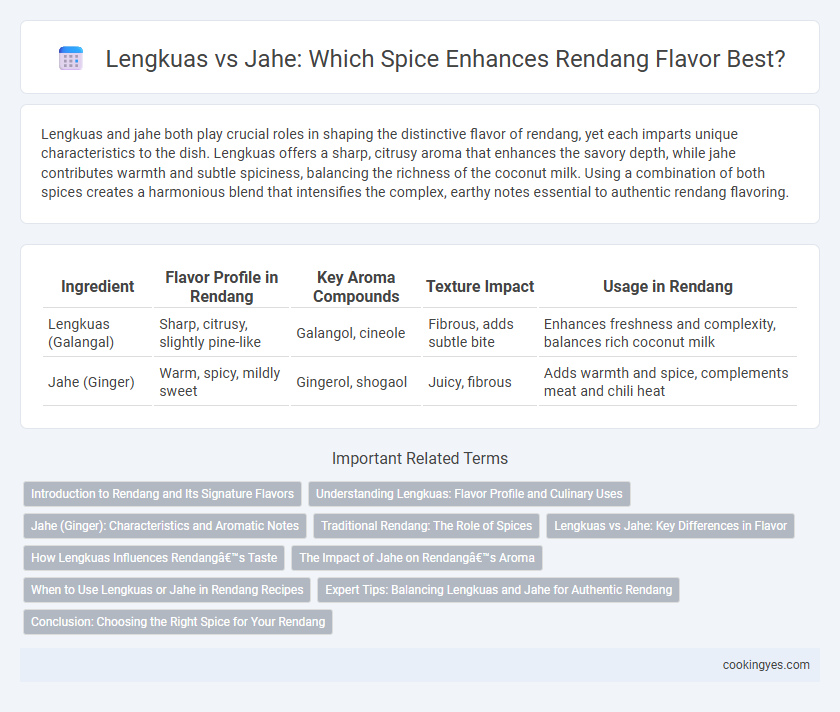Lengkuas and jahe both play crucial roles in shaping the distinctive flavor of rendang, yet each imparts unique characteristics to the dish. Lengkuas offers a sharp, citrusy aroma that enhances the savory depth, while jahe contributes warmth and subtle spiciness, balancing the richness of the coconut milk. Using a combination of both spices creates a harmonious blend that intensifies the complex, earthy notes essential to authentic rendang flavoring.
Table of Comparison
| Ingredient | Flavor Profile in Rendang | Key Aroma Compounds | Texture Impact | Usage in Rendang |
|---|---|---|---|---|
| Lengkuas (Galangal) | Sharp, citrusy, slightly pine-like | Galangol, cineole | Fibrous, adds subtle bite | Enhances freshness and complexity, balances rich coconut milk |
| Jahe (Ginger) | Warm, spicy, mildly sweet | Gingerol, shogaol | Juicy, fibrous | Adds warmth and spice, complements meat and chili heat |
Introduction to Rendang and Its Signature Flavors
Rendang, a rich Indonesian slow-cooked beef dish, relies heavily on the interplay of aromatic spices such as lengkuas (galangal) and jahe (ginger) to achieve its distinctive flavor profile. Lengkuas offers a sharp, citrusy spiciness with a hint of pine, enhancing the depth and complexity of the meat, while jahe provides a warm, zesty heat that balances the richness of the coconut milk and chili. The combination of these rhizomes creates the unrivaled savory and fragrant essence that defines authentic Rendang's signature taste.
Understanding Lengkuas: Flavor Profile and Culinary Uses
Lengkuas, also known as galangal, offers a sharp, citrusy, and slightly piney flavor essential to authentic Rendang, distinguishing it from the warmer, more pungent taste of jahe (ginger). Its aromatic complexity enhances the rich, spicy coconut-based sauce, contributing depth and brightness without overpowering other spices. Widely used in Indonesian and Malaysian cuisine, lengkuas is a key ingredient that balances the bold flavors fundamental to traditional Rendang recipes.
Jahe (Ginger): Characteristics and Aromatic Notes
Jahe (ginger) in Rendang contributes a warm, spicy, and slightly sweet flavor that enhances the dish's complexity and depth. Its sharp, pungent aroma balances the rich coconut milk and robust spices, creating a harmonious blend that intensifies the savory profile. Compared to lengkuas (galangal), ginger offers a more vibrant zest and a subtle citrus undertone, heightening the overall sensory experience of Rendang.
Traditional Rendang: The Role of Spices
Lengkuas (galangal) imparts a sharp, citrusy, and slightly piney flavor essential in traditional Rendang, enhancing its complex aromatic profile. Jahe (ginger) contributes warm, spicy, and sweet notes but lacks the distinctive earthiness and brightness that lengkuas offers. Authentic Rendang recipes prioritize lengkuas to achieve the signature balance of bold, layered spices that define this iconic Indonesian dish.
Lengkuas vs Jahe: Key Differences in Flavor
Lengkuas provides a sharp, citrusy, and slightly piney flavor essential for authentic Rendang, distinguishing it from jahe (ginger), which offers a warm, sweet, and spicy undertone. The robust aroma of lengkuas complements the rich coconut milk and complex spice mix, while jahe imparts a subtle heat and earthiness. Choosing between lengkuas and jahe significantly impacts the Rendang's traditional taste profile and aromatic depth.
How Lengkuas Influences Rendang’s Taste
Lengkuas, also known as galangal, imparts a sharp, citrusy aroma and a slightly piney flavor that enhances rendang's rich and spicy profile. Its unique pungency balances the creamy coconut milk and the deep, savory notes of slow-cooked beef, creating a complex flavor depth that jahe (ginger) cannot fully replicate. Incorporating lengkuas in rendang results in a more authentic and robust taste, distinguishing it from versions flavored primarily with ginger.
The Impact of Jahe on Rendang’s Aroma
Jahe, or ginger, plays a crucial role in enhancing Rendang's aroma by imparting a warm, spicy, and slightly sweet fragrance that complements the rich coconut and spice blend. Unlike lengkuas (galangal), which offers a sharp, citrusy, and pine-like scent, jahe provides a more subtle, earthy depth that elevates the overall sensory experience of the dish. The balance between these rhizomes shapes Rendang's distinctive aroma profile, with jahe intensifying its inviting and robust character.
When to Use Lengkuas or Jahe in Rendang Recipes
Lengkuas, also known as galangal, imparts a sharp, citrusy aroma that enhances the rich, spicy complexity of traditional rendang and is best used during the initial sauteing process to infuse the oil with its distinctive flavor. Jahe, or ginger, offers a warm, slightly sweet spiciness that complements the slow-cooked richness of rendang, making it ideal to add midway through cooking to balance the dish's depth without overpowering other spices. Using lengkuas in rendang recipes accentuates bright, herbal notes, while jahe contributes mellow heat, so choosing between them depends on whether a fresher or warmer spice profile is desired.
Expert Tips: Balancing Lengkuas and Jahe for Authentic Rendang
Expert tips for balancing lengkuas (galangal) and jahe (ginger) in rendang emphasize using slightly more lengkuas for its earthy, peppery aroma that defines authentic Padang flavor. Jahe adds a subtle warmth and sharpness, so incorporating it in smaller amounts prevents overpowering the dish's complex spices. Master chefs recommend finely slicing lengkuas for maximum infusion while grating ginger to release aromatic oils, achieving the perfect harmony in traditional rendang seasoning.
Conclusion: Choosing the Right Spice for Your Rendang
Lengkuas (galangal) offers a sharp, citrusy aroma and earthy undertones that enhance rendang's complex flavors, while jahe (ginger) provides a warm, spicy zest that adds brightness and heat. Selecting lengkuas maintains authenticity by delivering the traditional, deep-rooted taste characteristic of classic rendang, whereas jahe introduces a subtle, lively kick suitable for a lighter variation. For a true rendang experience, lengkuas is preferred, but jahe can be used to customize flavor profiles for personal or regional preferences.
Lengkuas vs Jahe for Rendang flavoring Infographic

 cookingyes.com
cookingyes.com